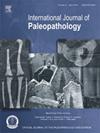A short and sickly life. Multi-indicator analysis of an infant from a late antique Italian burial site (Piano della Civita, Artena, 3rd-5th cent CE)
IF 1.5
3区 地球科学
Q3 PALEONTOLOGY
引用次数: 0
Abstract
Objective
To evaluate pathological lesions and related growth impairment in an infant from a late antiquity context in central Italy.
Materials
The individual labeled as 04.AR.60004 comes from a small burial plot in Piano della Civita di Artena, Italy, dated to the 3rd-5th centuries.
Methods
Macroscopic examination, metric analysis, dental histomorphometry, amelogenin sequencing, and aDNA analyses were employed.
Results
Individual 04.AR.60004 is an infant male with an estimated age-at-death of 2 months showing two metabolic stress events, one occurring before birth and one a few days before death. The well-preserved skeleton shows diffuse abnormal cortical porosity and subperiosteal new bone formation.
Conclusions
The type and distribution of the skeletal lesions suggest a diagnosis of infantile scurvy, probably associated with a general status of malnutrition. Dimensions of cranial and postcranial bones show a wide discrepancy between the skeletal age (38–40 fetal weeks) and the dental histological age (2 months).
Significance
Including enamel histology age-at-death estimation may expand our knowledge of the influence of severe pathological cases on growth.
Limitations
Although scurvy remains the most obvious diagnosis, we cannot exclude other related micronutrient deficiencies which might have affected the individual.
Suggestions for further research
Including dental histometric and molecular sex estimation in infant pathological cases can help us to recognize impaired growth and enhance our understanding of sex-based susceptibility and potential biases in childcare within ancient communities.
短暂而多病的一生。意大利古代晚期墓葬中一个婴儿的多指标分析(Piano della Civita, Artena,公元3 -5世纪)
目的评价意大利中部古代晚期一名婴儿的病理病变和相关的生长障碍。个人标签为04.AR。60004来自意大利Piano della Civita di Artena的一个小墓地,可以追溯到3 -5世纪。方法采用显微检查、计量学分析、牙组织形态学分析、淀粉原蛋白测序和dna分析。ResultsIndividual 04.基于“增大化现实”技术。60004是一名估计死亡年龄为2个月的男婴,表现出两次代谢应激事件,一次发生在出生前,另一次发生在死前几天。保存完好的骨骼显示弥漫性异常皮质孔隙和骨膜下新骨形成。结论骨骼病变的类型和分布提示诊断为婴儿坏血病,可能与营养不良有关。颅骨和颅后骨的尺寸显示骨骼年龄(38-40胎周)和牙齿组织学年龄(2个月)之间存在很大差异。意义包括牙釉质组织学的死亡年龄估计可以扩大我们对严重病理病例对生长影响的认识。虽然坏血病仍然是最明显的诊断,但我们不能排除其他可能影响个体的相关微量营养素缺乏。进一步研究的建议,包括在婴儿病理病例中进行牙齿组织和分子性别估计,可以帮助我们识别生长受损,增强我们对古代社区儿童保育中基于性别的易感性和潜在偏见的理解。
本文章由计算机程序翻译,如有差异,请以英文原文为准。
求助全文
约1分钟内获得全文
求助全文
来源期刊

International Journal of Paleopathology
PALEONTOLOGY-PATHOLOGY
CiteScore
2.90
自引率
25.00%
发文量
43
期刊介绍:
Paleopathology is the study and application of methods and techniques for investigating diseases and related conditions from skeletal and soft tissue remains. The International Journal of Paleopathology (IJPP) will publish original and significant articles on human and animal (including hominids) disease, based upon the study of physical remains, including osseous, dental, and preserved soft tissues at a range of methodological levels, from direct observation to molecular, chemical, histological and radiographic analysis. Discussion of ways in which these methods can be applied to the reconstruction of health, disease and life histories in the past is central to the discipline, so the journal would also encourage papers covering interpretive and theoretical issues, and those that place the study of disease at the centre of a bioarchaeological or biocultural approach. Papers dealing with historical evidence relating to disease in the past (rather than history of medicine) will also be published. The journal will also accept significant studies that applied previously developed techniques to new materials, setting the research in the context of current debates on past human and animal health.
 求助内容:
求助内容: 应助结果提醒方式:
应助结果提醒方式:


